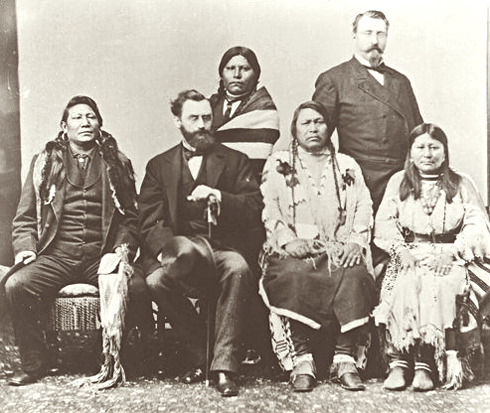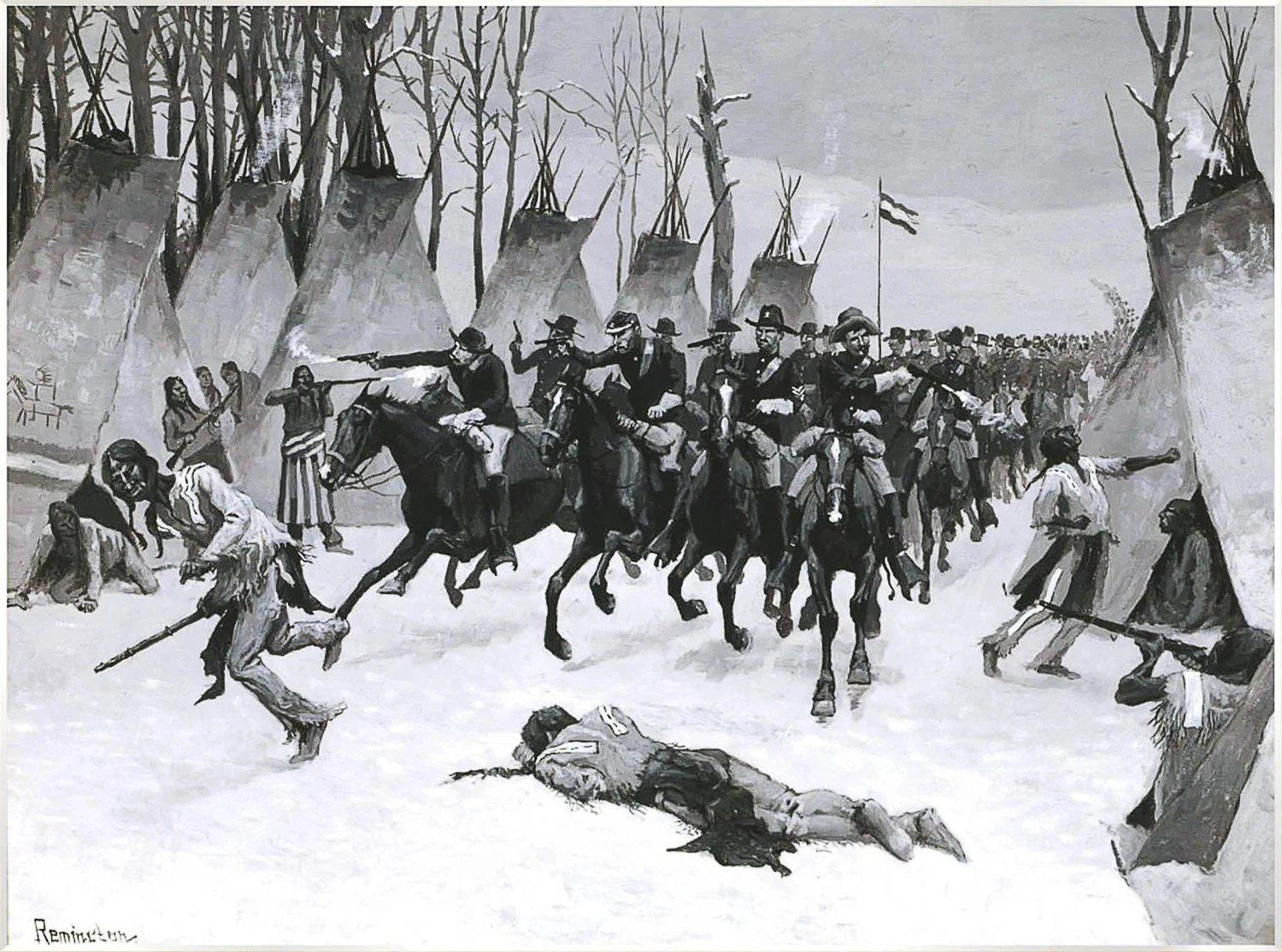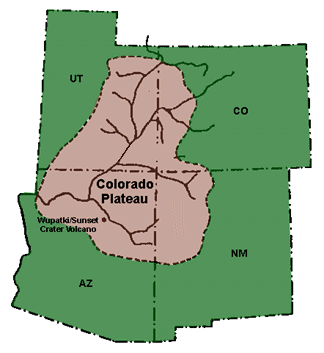|
Beaver Creek Massacre
Beaver Creek Massacre Site, located about Dolores, Colorado, occurred on June 19, 1885 between Ute Mountain Utes and white cattlemen over land use and Native American policies established for Native Americans. The last conflict of its kind in Colorado, it followed the Meeker Massacre (September 29, 1879) and Sand Creek Massacre (November 29, 1864). Six or eleven Ute Mountain Ute Tribe people were killed. Two or three days later, a white man and his family were attacked in Montezuma County. Mr. Genthner was killed and his wife was wounded. The Beaver Creek Massacre site is located along a dirt forest road in the Dolores Ranger District of the San Juan National Forest. It was added to the National Register of Historic Places on October 2, 1986. Background Utes had difficulty getting enough food to eat. They lived on the Ute Mountain Ute Tribe Reservation where they were supposed to hunt. The federal government was supposed to provide food rations for the Native Americans to compensa ... [...More Info...] [...Related Items...] OR: [Wikipedia] [Google] [Baidu] |
Dolores, Colorado
Dolores is a Statutory Town located in Montezuma County, Colorado, United States. The town population was 885 at the 2020 United States census. Description Dolores (Spanish for "sorrows" and named for the river on which it is located) is located at the mouth of the Dolores Valley and the upper reaches of McPhee Reservoir, approximately from the Four Corners Monument. Established as a station on the Rio Grande Southern Railroad, it replaced the earlier town, Big Bend, now covered by McPhee Reservoir. McPhee Reservoir is named for a company town founded by New Mexico Lumber Company, that is now covered by the reservoir. History The following are Dolores area historic sites of the Ancient Pueblo People: * The Canyons of the Ancients Visitor Center and Museum, and the on-site Domniguez and Escalante Pueblos are listed on the Colorado State Register of Historic Properties and the National Register of Historic Places listings in Montezuma County, Colorado. [...More Info...] [...Related Items...] OR: [Wikipedia] [Google] [Baidu] |
Meeker Massacre
Meeker Massacre, or Meeker Incident, White River War, Ute War, or the Ute Campaign), took place on September 29, 1879 in Colorado. Members of a band of Ute people, Ute Indians (Native Americans of the United States, Native Americans) attacked the Indian agency on their reservation, killing the Indian agent Nathan Meeker and his 10 male employees and taking five women and children as hostages. Meeker had been attempting to convert the Utes to Christianity, to make them farmers, and to prevent them from following their nomadic culture. On the same day as the massacre, United States Army forces were en route to the Agency from Fort Steele (Wyoming), Fort Steele in Wyoming due to threats against Meeker. The Utes attacked U.S. troops led by Major (rank), Major Thomas T. Thornburgh at Milk Creek, north of present day Meeker, Colorado. They killed the major and 13 troops. Relief troops were called in and the Utes dispersed. The conflict resulted in the Utes losing most of the lands ... [...More Info...] [...Related Items...] OR: [Wikipedia] [Google] [Baidu] |
Sand Creek Massacre
The Sand Creek massacre (also known as the Chivington massacre, the battle of Sand Creek or the massacre of Cheyenne Indians) was a massacre of Cheyenne and Arapaho people by the U.S. Army in the American Indian Genocide that occurred on November 29, 1864, when a 675-man force of the Third Colorado Cavalry under the command of U.S. Volunteers Colonel John Chivington attacked and destroyed a village of Cheyenne and Arapaho people in southeastern Colorado Territory, killing and mutilating an estimated 70 to over 600 Native American people. Chivington claimed 500 to 600 warriors were killed. However, most sources estimate around 150 people were killed, about two-thirds of whom were women and children.Reilly, H.J. (2011). Bound to have blood: Frontier newspapers and the Plains Indian genocide. Lincoln, NE: University of Nebraska Press p. 21Rajtar, Steve, ''Indian War Sites: A Guidebook to Battlefields, Monuments, and Memorials'', McFarland & Company, Inc., Jefferson, North Ca ... [...More Info...] [...Related Items...] OR: [Wikipedia] [Google] [Baidu] |
Ute Mountain Ute Tribe
The Ute Mountain Ute Tribe (Ute dialect: Wʉgama Núuchi) is one of three federally recognized tribes of the Ute Nation, and are mostly descendants of the historic Weeminuche Band who moved to the Southern Ute reservation in 1897. Their reservation is headquartered at Towaoc, Colorado, on the Ute Mountain Ute Indian Reservation in southwestern Colorado, northwestern New Mexico and small sections of Utah. History The Ute Mountain Ute Tribe are descendants of the Weeminuche bandPritzker, 245 (''Weminuche'', ''Weemeenooch'', ''Wiminuc'', ''Guiguinuches'') lived west of the Great Divide along the Dolores River of western Colorado, in the Abajo Mountains, in the Valley of the San Juan River its northern tributaries and in the San Juan Mountains including eastern Utah. They moved to the Southern Ute reservation in 1897. Two thousand years ago, the Utes lived and ranged in the mountains and desert over much of the Colorado Plateau present day eastern Utah, western Colorado, nor ... [...More Info...] [...Related Items...] OR: [Wikipedia] [Google] [Baidu] |
Montezuma County, Colorado
Montezuma County is a county located in the southwest corner of the U.S. state of Colorado. As of the 2020 United States census, 2020 census, the population was 25,849. The county seat is Cortez, Colorado, Cortez. Montezuma County contains many archaeologically significant Amerindian structures, which notably can be found in Mesa Verde National Park, Canyons of the Ancients National Monument, Yucca House National Monument, and Hovenweep National Monument. Montezuma County is also home to most of the Ute Mountain Indian Reservation, home of the Weeminuche Band of the Ute Nation, known as the Ute Mountain Ute Tribe, with its headquarters at Towaoc, Colorado, Towaoc. History Montezuma County has been settled since approximately AD 600, and had an estimated population of approximately 100,000, four times its current population, in the 12th century. However, a series of events caused virtually all permanent settlements to be abandoned between 1200 and 1300, and the area was contes ... [...More Info...] [...Related Items...] OR: [Wikipedia] [Google] [Baidu] |
National Register Of Historic Places
The National Register of Historic Places (NRHP) is the Federal government of the United States, United States federal government's official United States National Register of Historic Places listings, list of sites, buildings, structures, Historic districts in the United States, districts, and objects deemed worthy of Historic preservation, preservation for their historical significance or "great artistic value". The enactment of the National Historic Preservation Act (NHPA) in 1966 established the National Register and the process for adding properties to it. Of the more than one and a half million properties on the National Register, 95,000 are listed individually. The remainder are contributing property, contributing resources within historic district (United States), historic districts. For the most of its history, the National Register has been administered by the National Park Service (NPS), an agency within the United States Department of the Interior. Its goals are to ... [...More Info...] [...Related Items...] OR: [Wikipedia] [Google] [Baidu] |
Fort Lewis College
Fort Lewis College (FLC) is a public liberal arts college in Durango, Colorado, and the only four-year and graduate studies institution in the Four Corners region. FLC's historical evolution spans its origins as a U.S. military fort, an Indian boarding school, and eventually a public college. In accordance with a 1911 mandate, Fort Lewis College provides tuition-free education to qualified Native American Tribal and Alaska Native Village members. The college serves a diverse community comprising 37% Native American/Alaska Native learners, representing 166 Native American Tribes and Alaska Native Villages, 43% first-generation students, 42% Pell Grant recipients, and 15% Hispanic/Latinx students. In 2008, the U.S. Department of Education designated FLC as a Native American-Serving, Non-Tribal Institutions (NASNTI). FLC is also recognized as a First Generation-Serving Institution by the State of Colorado and an emerging Hispanic-Serving Institution (HSI). History The first Fo ... [...More Info...] [...Related Items...] OR: [Wikipedia] [Google] [Baidu] |





